In this bi-weekly series reviewing classic science fiction and fantasy books, Alan Brown looks at the front lines and frontiers of the field; books about soldiers and spacers, scientists and engineers, explorers and adventurers. Stories full of what Shakespeare used to refer to as “alarums and excursions”: battles, chases, clashes, and the stuff of excitement.
One of the reasons for the phenomenal success of the Star Wars movies is that they offer something for everyone. They are built around epic fantasy concepts like the hero’s journey and the adventures of a “chosen one.” They center on a power struggle between the Sith and the Jedi, beings with paranormal powers. They take us to worlds different than our own, and introduce us to a diverse range of alien races. They present a thrilling political struggle between freedom and tyranny. They are full of rogues and smugglers and other colorful characters. And, most importantly to me, they give us the chance to experience epic space battles, with the efforts of plucky space fighter pilots making up large part of the action. This week, Disney premiered a new animated show, Star Wars: Resistance, built around the adventures of fighter pilots. And this show follows in the footsteps of another Star Wars series also focused on pilots, books that brought us some glorious space combat back in the 1990s in a series that began with X-Wing: Rogue Squadron.
Some folks look down their nose at tie-in fiction, arguing that inferior work is produced when people work for hire and don’t own the intellectual property they work on. But a good author can use the rich background of the original material, take advantage of the reader’s advance knowledge of universe, and dive right into the action. And author Michael Stackpole is one of those writers who uses information drawn from the existing property to good effect, weaving in new characters and situations in order to produce excellent and well-realized stories. This novel, and all those in the X-Wing series, is well worth reading.
About the Author
Michael A. Stackpole (born 1957) is an American science fiction author as well as a role-playing and computer game designer whose career began in the 1970s and continues to this day. He is most widely known for fiction tied to media and gaming properties, including Star Wars and BattleTech. He has written fourteen books set in the BattleTech universe, where battles are waged by warriors piloting giant Mecha robots.
In addition to six books of the X-Wing series, Stackpole wrote I, Jedi, a novel that follows Rogue Squadron member Corran Horn as he develops Jedi powers and attends the Jedi Academy. He has also written two more Star Wars books, The New Jedi Order: Dark Tide I: Onslaught, and The New Jedi Order: Dark Tide II: Ruin.
Stackpole has written a number of original novels, with most of them set in fantasy universes. He has also produced quite a bit of short fiction, with some of it, like his novels, tied to media and gaming properties. He also writes articles on gaming.
The Star Wars Resurgence
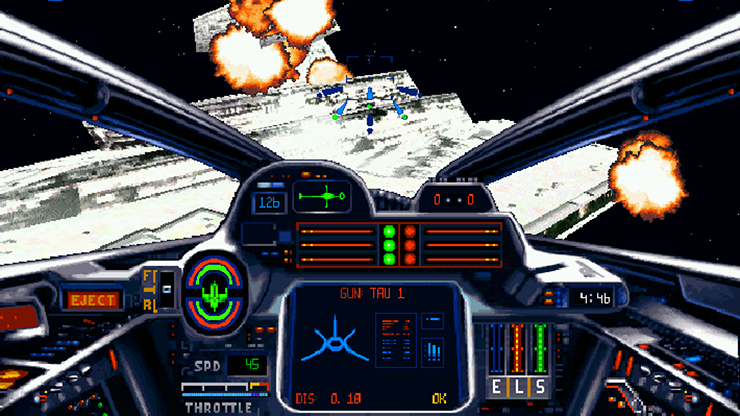
X-Wing: Rogue Squadron, released in 1996, is part of the resurgence of the Star Wars universe that began with Timothy Zahn’s Thrawn trilogy in 1991-1993, a publishing success that led to what became known as the Star Wars Expanded Universe. The book, and the combat described within, is clearly inspired by the setting of the very popular flight simulator games Star Wars: X-Wing and Star Wars: TIE Fighter, which were released in 1993 and 1994 respectively. Dark Horse Comics, which had been publishing Star Wars tie-in comics since the 1991 release of Star Wars: Dark Empire, released a Rogue Squadron comic book series, which presented additional adventures featuring some of the characters of the Rogue Squadron book series.
The release of X-Wing: Rogue Squadron preceded by a year the presentation of new editions of the original Star Wars films, retitled for this release as the Star Wars Trilogy: Special Edition. This was also a peak time for Star Wars merchandise, and a fan could buy replicas of pretty much any vehicle and major character they might desire—and not just those from the movies and novels, but also from comics and even video games. The success of this tie-in material, and the remastered movies, inspired Lucas to re-enter the Star Wars universe with the prequel trilogy, and kicked off a new era of the multi-media franchise that continues to be wildly popular today. The X-Wing series eventually included six books following Rogue Squadron, written by Stackpole, and four books following the adventures of the sister Wraith Squadron, written by Aaron Allston.
Star Wars: Resistance
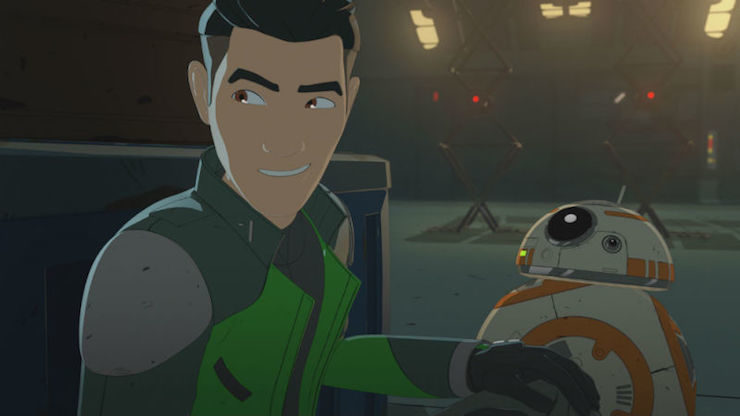
The space fighter action of the Rogue Squadron books is a clear precursor for the new animated TV show, Star Wars: Resistance, which follows the adventures of Kazuda Xiono, a young pilot in the New Republic Navy who is tasked by the Resistance with infiltrating a star fighter racing syndicate to spy on the growing First Order. The series is set shortly before the events described in the movie The Force Awakens. Just as the Rogue Squadron books used Wedge Antilles and other characters from the original trilogy movies as a link with the books, Star Wars: Resistance incorporates fighter pilot Poe Dameron and others from the most recent trilogy into the show. Young Kaz is a bit immature for someone already graduated from the Academy and serving as a fighter pilot, and some of the humor was a bit broad, but the first episode of the series was flashy and enjoyable, focusing on the excitement of racing star fighters. And that racing angle is a fun departure from combat in space, taking some obvious inspiration from the air racing that was popular in the 1930s. If someone at Disney is not already working on a flight simulator game based on this new series, they are missing a major opportunity…
Star Wars: X-Wing: Rogue Squadron
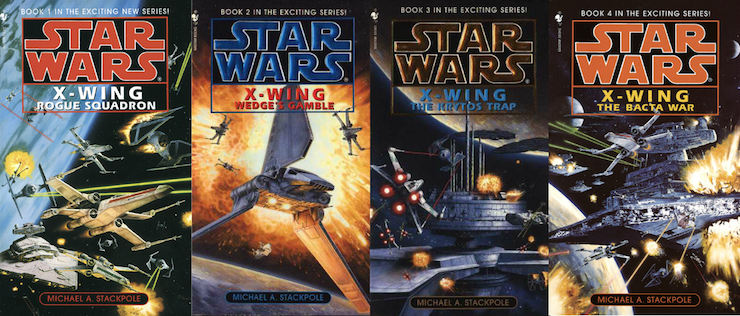
The book, which is set a few years after the movie Return of the Jedi, uses three primary viewpoint characters. The first, we are familiar with: Wedge Antilles, survivor of both Death Star battles in the original movie trilogy. He is a Commander now, and tasked with rebuilding the famous Rogue Squadron. The second is a new character, Corran Horn, a former member of the Corellian security agency who has joined the new Republic. The third viewpoint character is an old rival of Corran’s from Corellia, Kirtan Loor, who has become an Imperial intelligence officer and gives readers insight into the Imperial side of the conflict that helps build narrative tension. The book follows Rogue Squadron as it supports the Republic’s efforts to capture Coruscant, the Empire’s capital, and finally break the brutal regime that has survived destruction of the two Death Stars and the death of the Emperor.
The members of the new Rogue Squadron come from a variety of races, picked not only for their flying skills, but to represent their various planets. The executive officer is Tycho Celchu, an Alderaanian who had been captured by the Empire and escaped, but is not trusted by security because of fears of brainwashing. (While the character was not named in the movie, Tycho is presented as the A-Wing pilot who accompanied Lando and Wedge on the run into the second Death Star, and broke away to draw some TIE fighters off their tails.) A young relative of Luke Skywalker’s old friend Biggs, Gavin Darklighter, is barely accepted to the squadron because of his youth. We also meet a pair of spoiled heirs to bacta fortunes from the planet Thyferra; Bror Jace, a pilot who rivals Corran as the best new pilot in the squadron, and Erisi Dlarit, a female pilot who is attracted to Corran. Ooryl, an insect-like Gand, is a quirky, strange, but appealing character. There is an odd protocol droid, nicknamed Emtrey, which has peculiar but useful programming that makes it an excellent scrounger, manipulator of the supply system, and black marketeer. Complicating Corran’s life even further, Wedge is good friends with a young smuggler and supporter of the New Republic named Mirax Terrik. Corran and Mirax’s fathers were also in security and smuggling, and were arch-enemies throughout their careers, so while she and Corran are attracted to each other, the relationship has kind of a Montague and Capulet feel to it.
The story opens with what seems to be a space battle, but turns out to be one of the many simulator runs the squadron uses for training. Admiral Ackbar, Wedge’s superior, has high hopes for the new team. Wedge uses some of the training scenarios to remind Corran that, despite his personal skills, he needs to work as part of the team.
Buy the Book
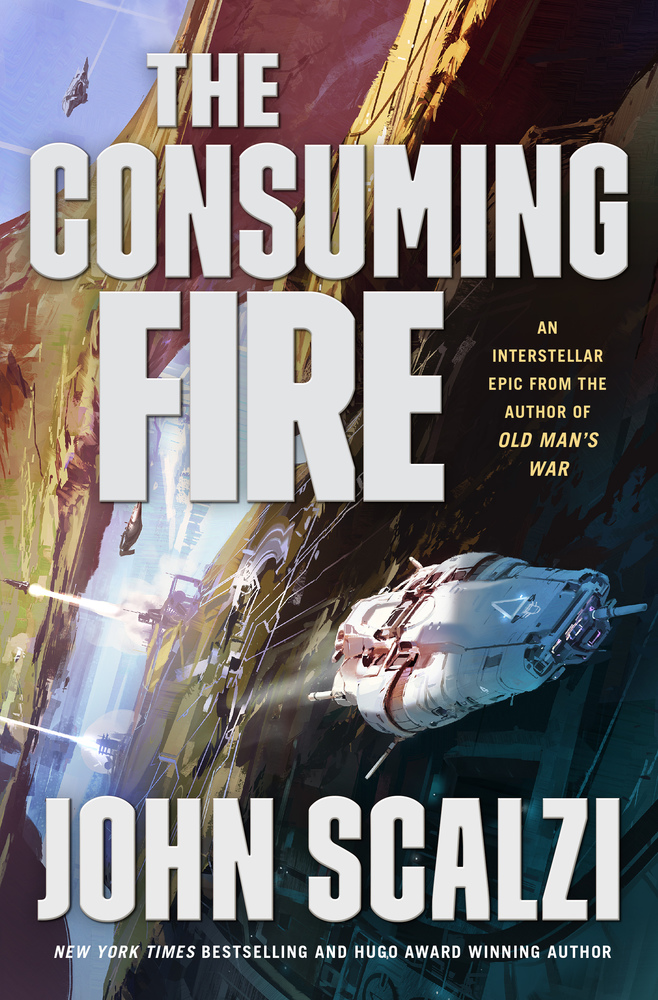

The Consuming Fire
Because of his intelligence skills and knowledge of Corran Horn, Kirtan Loor comes to the attention of Ysanne Isard, nicknamed Iceheart, the new ruler of what is left of the Empire, a ruthless and skillful tactician who worked her way up through the Imperial security apparatus. She tasks him with finding Rogue Squadron and coordinating their destruction. In the meantime, while they are not as ready as Wedge would like them to be, Ackbar decides to deploy Rogue Squadron to the front lines, putting them into combat situations. Despite their fears, the squadron’s first combat mission is a huge success, without anyone being lost. But their new base is discovered by stormtrooper commandoes, and after a fierce firefight, they suffer their first casualty. A second mission is more challenging, as they run into unexpected Imperial opposition, but the pilots handle the situation well.
The squadron is assigned to take part in a massive attack on an Imperial base, using Bothan intelligence—but the intelligence is wrong, the Bothan officers are wildly overconfident, the mission turns into a disaster, and the squadron takes heavy losses. Finding what they think is a weakness in the enemy defenses, they try again.
There is a lot of action in this book, and Stackpole does a convincing job of making you feel like you are in the cockpit with the pilots. I have played the X-Wing video games, and the action is consistent with the way the fighters handled in those games. The overall strategy is plausible, and presented in a straightforward manner. The shifting viewpoints help build tension, especially when you realize there is a spy embedded in the squadron—a mystery left hanging for future volumes. The characters are interesting, and they grow on you as the story progresses, which adds an emotional impact to the losses when they occur. It is difficult to juggle the large cast involved in a military story, but Stackpole handles it well and does a good job bringing the pivotal characters to life. As you near the end of the book, you realize that Stackpole is playing a long game, and the actual attack on Coruscant will occur in a future volume. But he brings the book to a very satisfying close, and leaves the reader wanting to read more of the continuing adventures of the squadron.
Final Thoughts
Star Wars: X-Wing: Rogue Squadron may have a somewhat bloated title, but the book itself is action-packed and rich in detail. The characters are compelling, and Stackpole does an excellent job of juggling the large cast. I enjoyed the book when I first read it, enjoyed re-reading it, and would highly recommend it to any Star Wars fan, or to fans of space combat stories in general.
Because of decisions made during the production of Star Wars: The Force Awakens to ignore the events of any Star Wars media outside the previous movies and animated TV series’, this book series is no longer considered part of the Star Wars canon, and has been rebranded as part of the Star Wars Legends books—but that doesn’t diminish the quality of the writing, or its entertainment value.
And now it’s your turn to talk: Have you read X-Wing: Rogue Squadron, or the other tales of the Rogue or Wraith Squadrons? If so, how did you like the books? Did you find them to be worthy heirs to the Star Wars tradition? And what are your thoughts on tie-in fiction in general?
Alan Brown has been a science fiction fan for over five decades, especially fiction that deals with science, military matters, exploration and adventure.










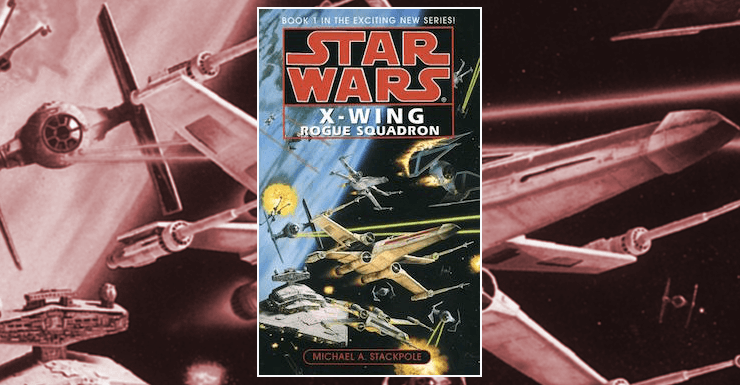
I’ll read this later, but YES. Loved the X-Wing series (both by Stackpole and then Allston), and I’ll always wish for a Rogue Squadron TV show, and hope that Resistance turns into something like that.
My reread blog of the preboot SWEU is in the middle of Rogue Squadron right now.
https://forcevisions.wordpress.com/
Ah, this is the point where I have to add that I have paid relatively little attention to post-1983 Star Wars so my nostalgia trip would involve Alan Dean Foster’s endearingly crazy Splinter of the Mind’s Eye.
Ties, like all fiction, are best when motivated primarily by love rather than money. The best one I read recently was Naomi Alderman’s Doctor Who: Borrowed Time; the simple yet effective thought experiment at the core of the plot clearly places it as kin to The Power.
I loved the X-Wing series as a kid. They’re the only Star Wars tie-in books I’ve hung onto over the years, in fact. Corran is a bit of a Mary Sue though — to be honest, I preferred the later Wraith Squadron books over the Rogue Squadron ones. Though Starfighters of Adumar was an exellent stand-alone romp.
Oh fantastic! This series gets forgotten easily, I’ve found. While Stackpole’s writing (and character treatment, especially with Corran) isn’t as good as Allston’s, both the Rogue and Wraith books are tons of fun.
I have to be honest: the Force/Jedi/lightsaber stuff has always been my least favorite part of Star Wars. That’s probably a huge reason why these are my all-time favorite Star Wars books. The two series – Rogue and Wraith – are totally different, but both great. The Rogue books are more “realistic” – for given values of realism, while the Wraith books tend to operate on a scaled up version of crazy.
Starfighters of Adumar is one of the only books I have ever laughed out loud while reading. It’s still probably my favorite Star Wars book of all time. If you haven’t read it, highly recommend it.
The X-wing series is my favorite Star Wars story, bar none. There were several years where I read them every six months or so, and I still relish the great humor and one-liners as much as the combat descriptions. There are so many quotable passages. Even the politics is interesting, and I hate politics. I feel they are an example of how you can have a thrilling, interesting story with both personal and military conflicts, without it feeling hopeless. The grimdark turn of the EU is what made me stop reading as they came out. I wish the authors would go back to this style.
@3 Splinter was a strange look at what the Star Wars universe might have looked like if Lucas had gone in some of the other directions he was considering. Another strange alternative view of the Star Wars universe as it might have been was the Dark Horse comic series The Star Wars, which followed the first draft of the movie’s script.
@6 – CSays: Yes, that’s exactly while I love these books. I like the Force stuff, but as a part of Star Wars, not when it dominates the whole story.
An artist friend of mine is an acquaintance of Stackpole, and confirmed that Stackpole played heavy amounts of X-Wing for research purposes.
This is still, by far, my favorite of all the EU. The Rouge Squadron comics are the series that got me into Star Wars comics to begin with. I really enjoyed Stackpole’s work and had been hesitant about Allston’s taking over the series, albeit with a different squadron, but all of his books continued to be great. I don’t usually like scifi books (or whatever Star Wars is) with a lot of space battles. I find them hard to follow, but this was not the case with Stackpole’s writing.
@11 Is the Rouge Squadron the one where everyone puts on too much makeup? ;-)
Cool article, Alan Brown. I enjoy reading your stuff here. Keep up the great work.
Read the article, good rundown. One thing, Rogue Squadron pilots were also chosen because they had additional skills that could be used in undercover and commando missions, that was an important part of the concept.
I loved all the characters and the interactions, and Stackpole sure wrote interesting adventures. The only thing that irked me a bit, and took me out of the story rhythm was the game designer in Stackpole needing to be very detailed in describing what lever was pulled or what pedal pushed for each maneuver in battle.
This is my favorite Star Wars line, and always will be.
I love all of Stackpole’s books. Corran Horn is tied with Mara Jade as my favorite EU/Legends character; they are the only ones I really miss. I eventually stopped reading the EU books during the Yuzaan Vong storyline as the continuity began to feel a bit bloated for my tastes.
Love these books, and the later coordination that Stackpole & Tim Zahn engaged in within their little pockets of the EU-that was were great fun. And how the Rogue Squadron comic book serves as a prequel to the novels, with characters appearing later in the books and events coming back to bite Wedge in the ass are really neat.
And really having to “play X-Wing for research”? Oh the hardship! (Although only someone who has really PLAYED that game can get across just how bastard-annoying The Redemption mission truly is…)
Oh, the comic book was very good too.
It’s articles like these that make me want a full EU/Legends reread feature here. I remember starting it back in the early 2000s, but I never got far enough along to the X-Wing series.
These were my favorite Star Wars books. I also loved the X-Wing and Tie Fighter games, so these books were right up my alley. I’ve thought of trying to find these books again, and now this article is the push I needed to do it. I played through the X-Wing game a couple years ago on gog.com and now I think I’ll jump into Tie Fighter, which was the better game. Better story and missions IMO. Thank you for the great article.
Oh man, memories!!! These are among my favorite EU books – and this surprised me. I discovered Star Wars in 1997 (yes, thanks to the special editions) and quickly set to devouring whatever other stories were out there. I wasn’t that enthusiastic about the Rogue Squadron books because I actually AM more a fan of the Jedi/Force stuff and the main characters. So I wasn’t sure how much I’d like a series focused on secondary characters and a bunch of space battles.
I loved it :) As you mention, Stackpole has so many great characters and seeing the covers of those books brings back some intense memories of sitting in my high school German class reading them during break – especially in the latter books there’s a lot of great intrigue and character development and suspense/drama and I got just as attached to these characters as any other in the movies. (I LOVE the Wraith Sqaudron books as well…in fact, there was a scene in one that actually brought tears to my eyes…). But Isard is one of my favorite Star Wars villains ever.
Stackpole also wrote Union, which covered the wedding of Luke and Mara (which was a big deal to me, lol).
Fun fact – my boyfriend at the time was really excited to hear that I loved Stackpole because he was a huge Battletech fan and so knew Stackpole from that – so then I ended up reading all his Battletech books (and many, many others). I never quite finished the series but man, I loved the Warrior series. Both of us ended up seeking out his original fiction and I’ve read a good portion of it (really enjoyed his DragonCrown cycle)..
In addition to writing about gaming, he’s been outspoken in the past about debunking a lot of the myths around occult influences and suicide in RPGs.
Thanks for this article :)
By and large, I was NOT a fan of the EU, but this series is a big favorite of mine. I read the first one in the hospital during recovery from an appendectomy, and then spent a good chunk of my senior year of high school reading these books instead of the ones I was supposed to read.
This article brought back pleasant memories. I loved the Rogue and Wraith Squadron series, in fact, they were my favourites in the expanded universe books. The characterisation was so great in these books and the X-Wing fight scenes were pretty exciting stuff too. One character that really made me chuckle (towards the end of the series) is Hawk Bat 1; the first Ewok pilot. The description of how he was able to fly an X-Wing was hilarious.
With the pulleys and the stilts. Yub yub, commander!
I love the X-Wing books. My favorite being Solo Command. Such a great characterization of Han!
I’m so glad to see you write about the Rogue Squadron series. It remains my favorite Star Wars fiction. And I still believe that Isan Ysard is the best Star Wars villain ever. I secretly hoped that with the Disney take-over of the SWU that the Rogue Squadron series might see life on the screen.
We still might, Marc.
I loved these books! Read them all at time of release and have re-read the series a handful of times.
I also love the repetetive use of the word tie in this post…